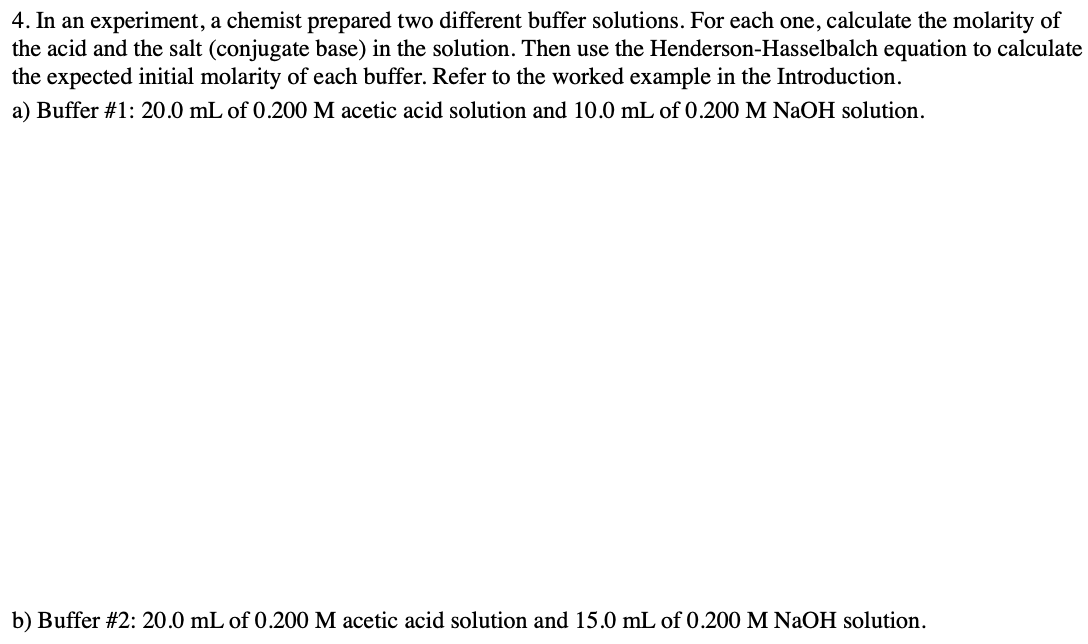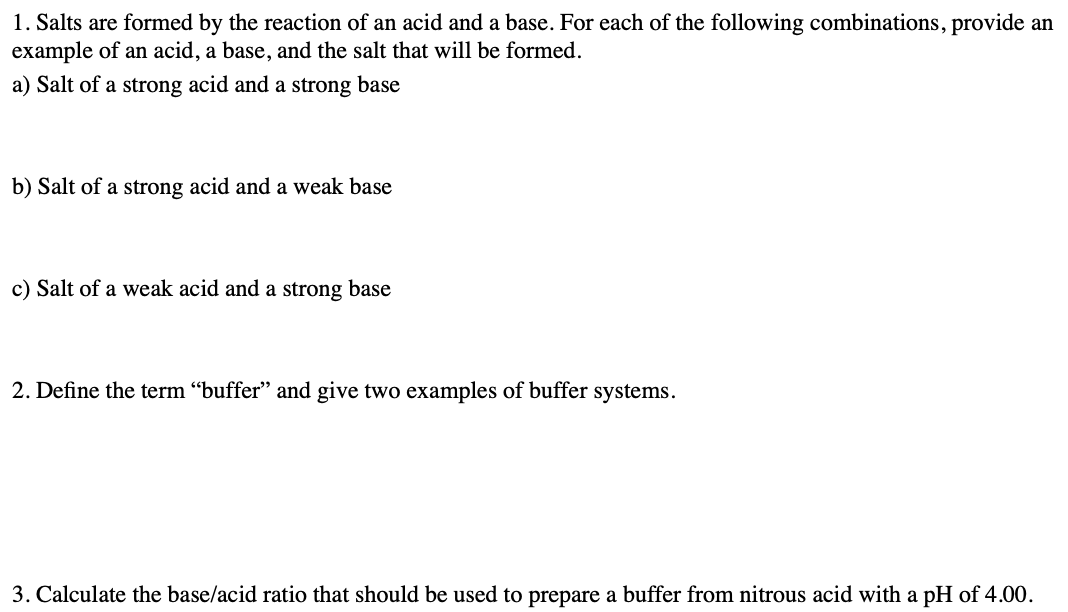In an experiment, a chemist prepared two different buffer solutions. For each one, calculate the molarity of e acid and the salt (conjugate base) in the solution. Then use the Henderson-Hasselbalch equation to calculate e expected initial molarity of each buffer. Refer to the worked example in the Introduction. Buffer #1: 20.0 mL of 0.200 M acetic acid solution and 10.0 mL of 0.200 M NaOH solution.
In an experiment, a chemist prepared two different buffer solutions. For each one, calculate the molarity of e acid and the salt (conjugate base) in the solution. Then use the Henderson-Hasselbalch equation to calculate e expected initial molarity of each buffer. Refer to the worked example in the Introduction. Buffer #1: 20.0 mL of 0.200 M acetic acid solution and 10.0 mL of 0.200 M NaOH solution.
Chemistry: The Molecular Science
5th Edition
ISBN:9781285199047
Author:John W. Moore, Conrad L. Stanitski
Publisher:John W. Moore, Conrad L. Stanitski
Chapter15: Additional Aqueous Equilibria
Section: Chapter Questions
Problem 108QRT
Related questions
Question

Transcribed Image Text:4. In an experiment, a chemist prepared two different buffer solutions. For each one, calculate the molarity of
the acid and the salt (conjugate base) in the solution. Then use the Henderson-Hasselbalch equation to calculate
the expected initial molarity of each buffer. Refer to the worked example in the Introduction.
a) Buffer #1: 20.0 mL of 0.200 M acetic acid solution and 10.0 mL of 0.200 M NaOH solution.
b) Buffer #2: 20.0 mL of 0.200 M acetic acid solution and 15.0 mL of 0.200 M NaOH solution.

Transcribed Image Text:1. Salts are formed by the reaction of an acid and a base. For each of the following combinations, provide an
example of an acid, a base, and the salt that will be formed.
a) Salt of a strong acid and a strong base
b) Salt of a strong acid and a weak base
c) Salt of a weak acid and a strong base
2. Define the term "buffer" and give two examples of buffer systems.
3. Calculate the base/acid ratio that should be used to prepare a buffer from nitrous acid with a pH of 4.00.
Expert Solution
This question has been solved!
Explore an expertly crafted, step-by-step solution for a thorough understanding of key concepts.
This is a popular solution!
Trending now
This is a popular solution!
Step by step
Solved in 3 steps with 2 images

Knowledge Booster
Learn more about
Need a deep-dive on the concept behind this application? Look no further. Learn more about this topic, chemistry and related others by exploring similar questions and additional content below.Recommended textbooks for you

Chemistry: The Molecular Science
Chemistry
ISBN:
9781285199047
Author:
John W. Moore, Conrad L. Stanitski
Publisher:
Cengage Learning

Principles of Modern Chemistry
Chemistry
ISBN:
9781305079113
Author:
David W. Oxtoby, H. Pat Gillis, Laurie J. Butler
Publisher:
Cengage Learning

Chemistry for Today: General, Organic, and Bioche…
Chemistry
ISBN:
9781305960060
Author:
Spencer L. Seager, Michael R. Slabaugh, Maren S. Hansen
Publisher:
Cengage Learning

Chemistry: The Molecular Science
Chemistry
ISBN:
9781285199047
Author:
John W. Moore, Conrad L. Stanitski
Publisher:
Cengage Learning

Principles of Modern Chemistry
Chemistry
ISBN:
9781305079113
Author:
David W. Oxtoby, H. Pat Gillis, Laurie J. Butler
Publisher:
Cengage Learning

Chemistry for Today: General, Organic, and Bioche…
Chemistry
ISBN:
9781305960060
Author:
Spencer L. Seager, Michael R. Slabaugh, Maren S. Hansen
Publisher:
Cengage Learning


Chemistry: Principles and Practice
Chemistry
ISBN:
9780534420123
Author:
Daniel L. Reger, Scott R. Goode, David W. Ball, Edward Mercer
Publisher:
Cengage Learning

World of Chemistry, 3rd edition
Chemistry
ISBN:
9781133109655
Author:
Steven S. Zumdahl, Susan L. Zumdahl, Donald J. DeCoste
Publisher:
Brooks / Cole / Cengage Learning